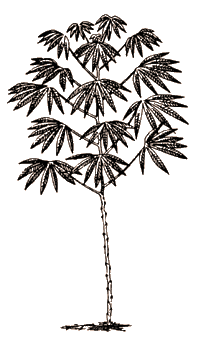
Articles
Cooking with cassava leaves
While reading Footsteps 43 on encouraging change, a reader from Kenya wondered whether cassava leaves are edible. Two people have responded with recipes
2001 Available in French, English, Spanish and Portuguese

While reading Footsteps 43 on encouraging change, a reader from Kenya wondered whether cassava leaves are edible. Two people have responded with recipes. Mr Gilbert comments, ‘The majority of people in our country (Democratic Republic of Congo) eat them as basic green vegetables.’ He shares the most common method used in the Bunia region where he lives. Mr Ramampiandra of Madagascar says that cassava leaves are widely used in his country.
Preparation
- Remove the old leaves and stalks until you have ten handfuls of young leaves, enough for a meal for three to four people.
- Heat a pan of water (five litres) to boiling point.
- Submerge handfuls of cassava leaves in the water for 4–5 minutes so as to remove the poison, then squeeze them hard to remove all the green liquid from the leaves, and then place them on a clean shelf to cool.
- Grind the leaves in a clean mortar.
Recipe one
- Add onions, leeks or garlic, or aubergines if available.
- Place in a pan with just enough water to cover the ground cassava leaves. Heat the mixture for 10–15 minutes, then add a little salt and at least 40ml of unrefined palm nut oil (or any other untreated vegetable oil).
- Tightly seal the pan and leave on low heat for at least an hour.
- Serve with dishes such as rice, plantain bananas, chikwange or fufu paste that is prepared using cassava flour.
Recipe two
Cook the ground cassava leaves with pieces of pork meat and fat, a little salt and enough water to cover. Cook gently for an hour.
Recipe three
Cook the ground cassava leaves with plenty of groundnut paste, a little salt and enough water to cover. Cook gently for 30 minutes.
Remember that some varieties of cassava contain a lot of the poison cyanide. Use ‘sweet’ cassava varieties. After cooking, the above mixtures should not taste bitter. If they do, they should not be eaten.
Kabangu-Wa-Katanga Gilbert, c/o Father Mark Denecker, PO Box 134, Païdha, Uganda Christian Ramampiandra, BP 37, 321 – Vohipeno, Madagascar
Similarly Tagged Content
Share this resource
If you found this resource useful, please share it with others so they can benefit too.

Subscribe to Footsteps magazine
A free digital and print magazine for community development workers. Covering a diverse range of topics, it is published three times a year.
Sign up now - Subscribe to Footsteps magazine




